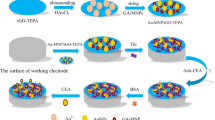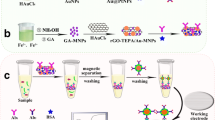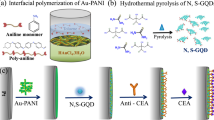Abstract
A sensitive electrochemical strategy for carcinoembryonic antigen 15–3 (CA15-3) detection is reported using CTAB-Co-MOFs@AuPt NPs as signal probes. The electrochemical strategy was designed as follows: First, the graphene aerogel@gold nanoparticles (GA@Au NPs) nanocomposites were employed to modify the sensing surface for promoting electron transfer rate and primary antibody (Ab1) immobilization due to GA possesses a large specific surface area, eminent conductivity, and a 3D network structure. Cobalt metal–organic frameworks (CTAB-Co-MOFs) synthesized were then used as a carrier for AuPt NPs and secondary antibody (Ab2) immobilization (notes: labelled-Ab2). With sandwich immunoreaction, the labelled-Ab2 was captured on the surface of the GA@Au NPs nanocomposites. Finally, differential pulse voltammetry (DPV) was employed to register the electrochemical signal of the immunosensor at the potential of − 0.85 V (vs SCE) in phosphate buffer saline (PBS) containing 2.5 mM H2O2. It was verified that the electrochemical reduction signal from Co3+ to Co2+ was recorded. The AuPt NPs could catalyze the reaction of H2O2 oxidizing Co2+ to Co3+, resulting in the amplification of the electrochemical signal. Under the selected conditions, the immunosensor can detect CA15-3 in the range 10 µU/mL to 250 U/mL with a low detection limit of 1.1 µU/mL. In the designed strategy, the CTAB-Co-MOFs were not only employed as carriers for AuPt NPs, but also acted as signal probes. The CTAB-Co-MOFs were investigated including SEM, TEM, XPS, and XRD. The application ability of the immunosensor was evaluated using serum sample, demonstrating the immunosensor can be applied to clinic serum analysis.
Graphical Abstract








Similar content being viewed by others
References
Sung H, Ferlay J, Siegel RL, Laversanne M, Soerjomataram I, Jemal A, Bray F (2021) Global Cancer Statistics 2020: GLOBOCAN estimates of incidence and mortality worldwide for 36 cancers in 185 countries. CA A Cancer J Clin 71(3):209–249
Xiong X, Zhang Y, Wang YF, Sha HF, Jia NQ (2019) One-step electrochemiluminescence immunoassay for BC biomarker CA 15–3 based on Ru(bpy)62+-coated UiO-66-NH2 metal-organic framework. Sens Actuat B Chem 297:126812
Ribeiro JA, Sales MGF, Pereira CM (2021) Electrochemistry-assisted surface plasmon resonance biosensor for detection of CA 15–3. Anal Chem 93(22):7815–7824
Peng MX, Lin SY, Lin ZB, Zheng DL, Song YB, Lu FS, Chen YW, Gao WH (2022) Rationally constructed ZnCdS-HDCs@In2S3-HNRs double-hollow heterojunction with promoted light capture capability for photoelectrochemical biosensing. Biosens Bioelectron 201:113957
Jiang XY, Wang HJ, Yuan R, Chai YQ (2015) Sensitive electrochemiluminescence detection for CA15-3 based on immobilizing luminol on dendrimer functionalized ZnO nanorods. Biosens Bioelectron 63:33–38
Wu YW, Chen XL, Wang XF, Yang M, Xu FL, Hou CJ, Huo DQ (2021) A fluorescent biosensor based on prismatic hollow Metal-polydopamine frameworks and 6-carboxyfluorescein (FAM)-labeled protein aptamer for CA15-3 detection. Sensors Actuat B-Chem 329:129249
Ambrosi A, Airo F, Merkoci A (2010) Enhanced gold nanoparticle based ELISA for a BC biomarker. Anal Chem 82(3):1151–1156
Ge XY, Feng YG, Cen SY, Wang AJ, Mei LP, Luo XL, Feng JJ (2021) A label-free electrochemical immnunosensor based on signal magnification of oxygen reduction reaction catalyzed by uniform PtCo nanodendrites for highly sensitive detection of carbohydrate antigen 15–3. Anal Chim Acta 1176:338750
Feng YG, He JW, Chen DN, Jiang LY, Wang AJ, Bao N, Feng JJ (2022) A sandwich-type electrochemical immunosensor for CYFRA 21–1 based on probe-confined in PtPd/polydopamine/hollow carbon spheres coupled with dendritic Au@Rh nanocrystals. Microchim Acta 189:271
Thangapandi K, Arumugam S, Amalesh N, Ajeet K, Saikat K (2021) Bio-nanocomposite based highly sensitive and label-free electrochemical immunosensor for endometriosis diagnosticsapplication. Bioelectrochemistry 139:107740–107749
Jin H, Mo K, Wen F, Li Y (2019) Preparation and pervaporation performance of CAU-10-H MOF membranes. J Membrane Sci 577:129–136
Zhi D, Li T, Li J, Ren H, Meng F (2021) A review of three-dimensional graphene-based aerogels: Synthesis, structure and application for microwave absorption. Compos Part B-Eng 211:108642
Sahoo BB, Kumar N, Panda HS, Panigrahy B, Sahoo NK, Soam A, Mahanto BS, Sahoo PK (2021) Self-assembled 3D graphene-based aerogel with Au nanoparticles as high-performance supercapacitor electrode. J Energy Storage 43:103157
Santos-Gómez LD, García JR, Montes-Morán MA, Menéndez JA, García-Granda S, Arenillas A (2021) Ultralight-weight graphene aerogels with extremely high electrical conductivity. Small 17(41):2103407
Liu XT, Pang K, Yang H, Guo XZ (2020) Intrinsically microstructured graphene aerogel exhibiting excellent mechanical performance and super-high adsorption capacity. Carbon 161:146–152
Maleki H (2016) Recent advances in aerogels for environmental remediation applications: A review. Chem Eng J 300:98–118
Öner E, Öztürk A, Yurtcan AB (2020) Utilization of the graphene aerogel as PEM fuel cell catalyst support: effect of polypyrrole (PPy) and polydimethylsiloxane (PDMS) addition. Int J Hydrogen Energy 45:34818–34836
Indra A, Song T, Paik U (2018) Metal organic framework derived materials: progress and prospects for the energy conversion and storage. Adv Mater 30:1705146
Li Z, Xi Y, Zhao A, Jiang J, Li B, Yang X, He J, Li F (2021) Cobalt-imidazole metal-organic framework loaded with luminol for paper-based chemiluminescence detection of catechol with use of a smartphone. Anal Bioanal Chem 413(13):3541–3550
Liu SY, Lai C, Liu XG, Li BS, Zhang C, Qin L, Huang DL, Yi H, Zhang MM, Li L, Wang WJ, Zhou XR, Chen L (2020) Metal-organic frameworks and their derivatives as signal amplification elements for electrochemical sensing. Coordin Chem Rev 424:213520
Guan Y, Si PB, Yang T, Wu Y, Yang TH, Hu R (2023) A novel method for detection of ochratoxin A in foods—Co-MOFs based dual signal ratiometric electrochemical aptamer sensor coupled with DNA walker. Food Chem 403:134316
Liu JB, Shang YH, Zhu QY, Zhang XX, Zheng JB (2019) A voltammetric immunoassay for the carcinoembryonic antigen using silver(I)-terephthalate metal-organic frameworks containing gold nanoparticles as a signal probe. Microchim Acta 186:509
Li MY, Zhang TT, Zhang YZ (2023) Ultrasensitive electrochemical sensing platform for miRNA-21 detection based on manganese dioxide-gold nanoparticle nanoconjugates coupled with hybridization chain reaction and horseradish peroxidase signal amplification. Analyst 148(9):2180–2188
Liu JB, Fu SH, Yuan B, Li YL, Deng ZX (2010) Toward a universal “adhesive nanosheet” for the assembly of multiple nanoparticles based on a protein-induced reduction/decoration of graphene oxide. J Am Chem Soc 132(21):7279–7281
Zhu XF, Yuan S, Ju SY, Yang J, Zhao C, Liu H (2019) Water splitting-assisted electrocatalytic oxidation of glucose with a metal-organic framework for wearable nonenzymatic perspiration sensing. Anal Chem 91(16):10764–10771
Zhang TT, Ma Y, Zhang YZ (2023) A simple electrochemical strategy for the detection of the cancer marker CA19-9 by signal amplification using copper organic framework nanocomposite. Analyst 148(23):5905–5914
Zhang LX, Xian JX, Xiang XX, Ouyang H, Wang L, Fu ZF (2022) Surfactant-assisted synthesis of water-stable cobalt-imidazole metal organic frameworks as signal probes for chemiluminescent immunoassay. Sensors Actuat B-Chem 373:132774
Huang Q, Guo Y, Chen D, Zhang L, Li TT, Hu Y, Qian J, Huang S (2021) Rational construction of ultrafine noble metals onto carbon nanoribbons with efficient oxygen reduction in practical alkaline fuel cell. Chem Eng J 424:130336
Oladipo AO, Iku SII, Ntwasa M, Nkambule TTI, Mamba BB, Msagati TAM (2020) Doxorubicin conjugated hydrophilic AuPt bimetallic nanoparticles fabricated from phragmites australis: characterization and cytotoxic activity against human cancer cells. J Drug Deliv Sci Technol 57:101749
Ke H, Zhang X, Huang CS, Jia NQ (2018) Electrochemiluminescence evaluation for carbohydrate antigen 15–3 based on the dual-amplification of ferrocene derivative and Pt/BSA core/shell nanospheres. Biosens Bioelectron 103:62–68
Wang AJ, Zhu XY, Chen Y, Luo XL, Xue YD, Feng JJ (2019) Ultrasensitive label-free electrochemical immunoassay of carbohydrate antigen 15–3 using dendritic Au@Pt nanocrystals/ferrocene-grafted-chitosan for efficient signal amplification. Sens Actuators B, Chem 292:164–170
Funding
This work is supported by the Nature Science Foundation of the Education Department of Anhui Province (No KJ2016A848).
Author information
Authors and Affiliations
Corresponding author
Ethics declarations
Ethics approval
All experiments were performed in accordance with the relevant laws and institutional guidelines of China, and approved by the ethics committee at Anhui Normal University (AHNU-ET2023051).
Conflict of interest
The authors declare no competing interests.
Additional information
Publisher's Note
Springer Nature remains neutral with regard to jurisdictional claims in published maps and institutional affiliations.
Supplementary Information
Below is the link to the electronic supplementary material.
Rights and permissions
Springer Nature or its licensor (e.g. a society or other partner) holds exclusive rights to this article under a publishing agreement with the author(s) or other rightsholder(s); author self-archiving of the accepted manuscript version of this article is solely governed by the terms of such publishing agreement and applicable law.
About this article
Cite this article
Zhang, T., Ma, Y., Tian, R. et al. CTAB-Co-MOFs@AuPt NPs as signal probes for the electrochemical detection of carcinoembryonic antigen 15–3. Microchim Acta 191, 176 (2024). https://doi.org/10.1007/s00604-024-06254-y
Received:
Accepted:
Published:
DOI: https://doi.org/10.1007/s00604-024-06254-y




